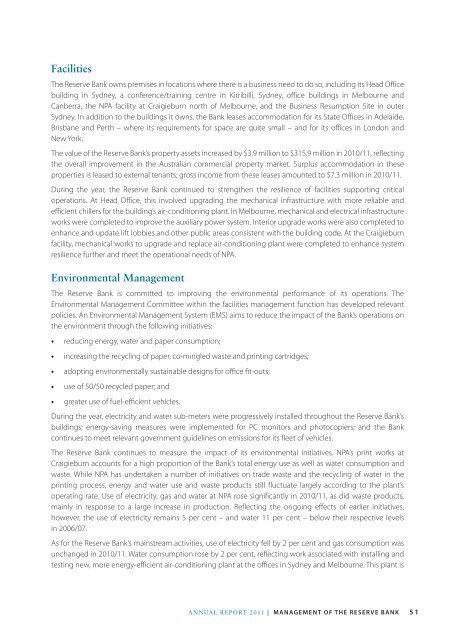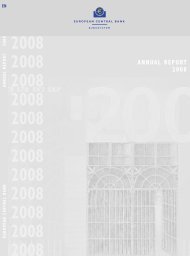Reserve Bank of Australia Annual Report 2011
Reserve Bank of Australia Annual Report 2011
Reserve Bank of Australia Annual Report 2011
You also want an ePaper? Increase the reach of your titles
YUMPU automatically turns print PDFs into web optimized ePapers that Google loves.
Facilities<br />
The <strong>Reserve</strong> <strong>Bank</strong> owns premises in locations where there is a business need to do so, including its Head Office<br />
building in Sydney, a conference/training centre in Kirribilli, Sydney, <strong>of</strong>fice buildings in Melbourne and<br />
Canberra, the NPA facility at Craigieburn north <strong>of</strong> Melbourne, and the Business Resumption Site in outer<br />
Sydney. In addition to the buildings it owns, the <strong>Bank</strong> leases accommodation for its State Offices in Adelaide,<br />
Brisbane and Perth – where its requirements for space are quite small – and for its <strong>of</strong>fices in London and<br />
New York.<br />
The value <strong>of</strong> the <strong>Reserve</strong> <strong>Bank</strong>’s property assets increased by $3.9 million to $315.9 million in 2010/11, reflecting<br />
the overall improvement in the <strong>Australia</strong>n commercial property market. Surplus accommodation in these<br />
properties is leased to external tenants; gross income from these leases amounted to $7.3 million in 2010/11.<br />
During the year, the <strong>Reserve</strong> <strong>Bank</strong> continued to strengthen the resilience <strong>of</strong> facilities supporting critical<br />
operations. At Head Office, this involved upgrading the mechanical infrastructure with more reliable and<br />
efficient chillers for the building’s air-conditioning plant. In Melbourne, mechanical and electrical infrastructure<br />
works were completed to improve the auxiliary power system. Interior upgrade works were also completed to<br />
enhance and update lift lobbies and other public areas consistent with the building code. At the Craigieburn<br />
facility, mechanical works to upgrade and replace air-conditioning plant were completed to enhance system<br />
resilience further and meet the operational needs <strong>of</strong> NPA.<br />
Environmental Management<br />
The <strong>Reserve</strong> <strong>Bank</strong> is committed to improving the environmental performance <strong>of</strong> its operations. The<br />
Environmental Management Committee within the facilities management function has developed relevant<br />
policies. An Environmental Management System (EMS) aims to reduce the impact <strong>of</strong> the <strong>Bank</strong>’s operations on<br />
the environment through the following initiatives:<br />
••<br />
reducing energy, water and paper consumption;<br />
••<br />
increasing the recycling <strong>of</strong> paper, co-mingled waste and printing cartridges;<br />
••<br />
adopting environmentally sustainable designs for <strong>of</strong>fice fit-outs;<br />
••<br />
use <strong>of</strong> 50/50 recycled paper; and<br />
••<br />
greater use <strong>of</strong> fuel-efficient vehicles.<br />
During the year, electricity and water sub-meters were progressively installed throughout the <strong>Reserve</strong> <strong>Bank</strong>’s<br />
buildings; energy-saving measures were implemented for PC monitors and photocopiers; and the <strong>Bank</strong><br />
continues to meet relevant government guidelines on emissions for its fleet <strong>of</strong> vehicles.<br />
The <strong>Reserve</strong> <strong>Bank</strong> continues to measure the impact <strong>of</strong> its environmental initiatives. NPA’s print works at<br />
Craigieburn accounts for a high proportion <strong>of</strong> the <strong>Bank</strong>’s total energy use as well as water consumption and<br />
waste. While NPA has undertaken a number <strong>of</strong> initiatives on trade waste and the recycling <strong>of</strong> water in the<br />
printing process, energy and water use and waste products still fluctuate largely according to the plant’s<br />
operating rate. Use <strong>of</strong> electricity, gas and water at NPA rose significantly in 2010/11, as did waste products,<br />
mainly in response to a large increase in production. Reflecting the ongoing effects <strong>of</strong> earlier initiatives,<br />
however, the use <strong>of</strong> electricity remains 5 per cent – and water 11 per cent – below their respective levels<br />
in 2006/07.<br />
As for the <strong>Reserve</strong> <strong>Bank</strong>’s mainstream activities, use <strong>of</strong> electricity fell by 2 per cent and gas consumption was<br />
unchanged in 2010/11. Water consumption rose by 2 per cent, reflecting work associated with installing and<br />
testing new, more energy-efficient air-conditioning plant at the <strong>of</strong>fices in Sydney and Melbourne. This plant is<br />
ANNUAL REPORT <strong>2011</strong> | Management <strong>of</strong> the <strong>Reserve</strong> <strong>Bank</strong><br />
51





![KNOW YOUR NEW GIBRALTAR BANKNOTES - [Home] bThe/b](https://img.yumpu.com/50890985/1/184x260/know-your-new-gibraltar-banknotes-home-bthe-b.jpg?quality=85)
![PAPUA NEW GUINEA - [Home] - Polymer Bank Notes of the World](https://img.yumpu.com/49758743/1/190x143/papua-new-guinea-home-polymer-bank-notes-of-the-world.jpg?quality=85)










